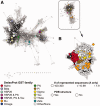Pythoscape: a framework for generation of large protein similarity networks
- PMID: 22962345
- PMCID: PMC3476340
- DOI: 10.1093/bioinformatics/bts532
Pythoscape: a framework for generation of large protein similarity networks
Abstract
Pythoscape is a framework implemented in Python for processing large protein similarity networks for visualization in other software packages. Protein similarity networks are graphical representations of sequence, structural and other similarities among proteins for which pairwise all-by-all similarity connections have been calculated. Mapping of biological and other information to network nodes or edges enables hypothesis creation about sequence-structure-function relationships across sets of related proteins. Pythoscape provides several options to calculate pairwise similarities for input sequences or structures, applies filters to network edges and defines sets of similar nodes and their associated data as single nodes (termed representative nodes) for compression of network information and output data or formatted files for visualization.
Figures

References
-
- Mannervik B, Danielson UH. Glutathione transferases—structure and catalytic activity. CRC Crit. Rev. Biochem. 1988;23:283–337. - PubMed

